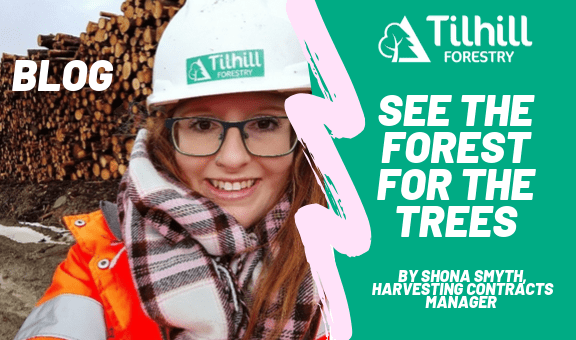Hi everyone, welcome to my second blog post! As I mentioned in my first post, all about the ICF Harvesting and Marketing Study Tour, I started out my forestry career in forest management, before changing to the harvesting sector. So, what’s the difference and how did I get here?
Like many of my peers, I joined Tilhill Forestry via their graduate programme. I started in September 2015 after completing a BSc (Hons) in Countryside and Environmental management at Harper Adams. Did I know what sector of forestry I wanted to work in? Not really. All I knew was that I wanted to be in the forestry sector and my interest was in commercial timber production. In complete disbelief that I was offered a position, I was placed in the North and Central England office as an Assistant Forest Manager. For 12 months I was just absorbing everything I could about the industry but something wasn’t clicking for me. I was working mainly on planting, establishment and maintenance schemes, with little involvement in the world of timber harvesting and products.
After being involved with a couple of harvesting operations as part of the management plans, my curiosity grew; there appeared to be more to harvesting than cutting down trees. As part of the graduate programme, I asked to spend some time with the harvesting team. Suddenly, I was exposed to a different perspective of the industry and a second side to the forestry business. I’d seen machinery working before, but this allowed me to appreciate harvesting from a different perspective. There was a whole ream of questions I wanted to ask around working out product breakouts, to pricing operations, timber stocks, haulage management and environmental protection.
Eighteen months into the graduate programme, I had made a transfer to South Wales, still as an Assistant Forest Manager, after exchanging with Andy Baker (see his blog post Relocation, Relocation, Relocation) in the hope that a more commercial focus would allow me to experience larger scale harvesting schemes.
My role soon became split between forestry and harvesting; for two days a week I was a Harvesting Supervisor. Come the following February, I had transferred into harvesting full time as a Harvesting Contracts Manager. I’ve now been in my current role for over 12 months and looking at stepping up to become a Harvesting Manager. Like many people in forestry, when I am trying to explain what it is I do, I am faced with the “oh cool, so that’s cutting down trees and planting them again”. To a certain extent, this perception isn’t wrong and it’s good to hear that the overall view of forestry is slowly changing. A lot of my day to day is based around logistics and monitoring harvesting operations to make sure that we are complying with health and safety and environmental regulations. Another part of my role is ensuring that harvesting is managed efficiently to supply the required quantities of products to various markets. Now, I am becoming more involved with pricing whole operations and managing them independently, as well as setting up contracts and negotiating sales. This involves inspecting new lots (standing timber) and estimating and checking volume, working costs, breakout and sales potential. A key role for me as I progress will be to build positive working relationships with contractors, suppliers and customers to ensure that the client is getting the best price possible for their timber based on the current markets.
As you’ve probably read from other Tilhill Forestry blogs, a lot of forest management is learning on the job. I can say that I have seen the forestry life cycle from start to finish – and been involved in all stages at some level too. The graduate programme has definitely been beneficial for me in being able to almost “try before you buy.” The forest industry has a variety of career paths and there certainly isn’t a standard day.




